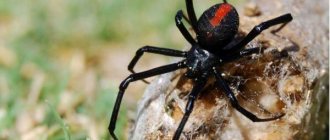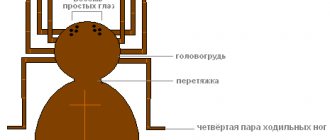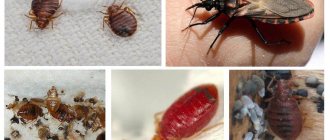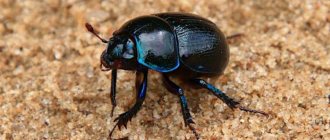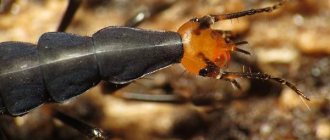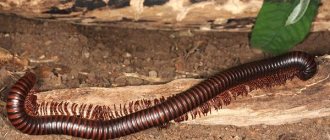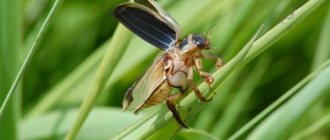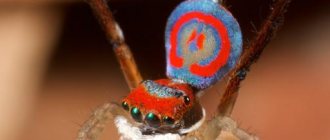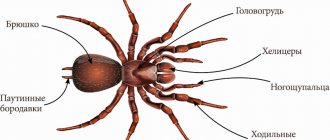The cross spider is a representative of the suborder of araneomorphic spiders of the orb-weaver family. There are more than 600 species of these arthropods in the world. The distribution area of the crusaders is quite extensive - they can be found on almost all continents except Antarctica. About 30 species of these arachnids live in our latitudes.
Spiders of this genus represent a striking case of sexual dimorphism. In addition to differences in the genitals, two heterosexual crosses differ in size, color, habits and other characteristics. After reading this article to the end, readers will become familiar with many interesting details from the life of these tiny creatures, and will also find out how dangerous a spider bite is for humans.
Appearance and dimensions of the cross spider
Almost every person has repeatedly encountered representatives of the genus Araneus. These arachnids got their name due to their distinctive characteristic feature. On the spider's abdomen, light spots form a kind of cross. The coloring of the crusaders depends on the environment. The sunny the spider’s habitat, the lighter its color.
Like all representatives of the arachnid order, the body of the spider is divided into a cephalothorax (prosoma) and abdomen (opisthosoma), connected by a movable stalk. The body is covered with a durable cuticle containing chitin and proteins. There are arachnoid warts on the spider's abdomen.
Crusaders have four pairs of simple eyes located on the cephalothorax, which provide them with all-round vision. However, their eyesight is poor. They see only blurry silhouettes and approaching shadows. Sensitive hairs, trichobothria, located over the entire surface of the body help spiders navigate their environment. There are especially many of them on the limbs. Eight walking legs are attached to the cephalothorax, as well as jaws - chelicerae and pedipalps.
- Chelicerae are designed to capture and puncture food. They consist of two segments and end in claws. When capturing prey, the crossfish injects a nerve agent from venom glands located at the base of these limbs.
- Pedipalps serve as an organ of touch for spiders. With their help, they hold and feel their prey. The functions of the pedipalps also include reproduction, since their terminal segment contains the copulatory apparatus, which is filled with seminal fluid before mating.
The sizes of cross spiders are small, and they differ significantly among individuals of different sexes. Males grow no more than 1 cm, adult females reach 2–4 cm in length. During their lives, crusaders change their chitinous cover several times, and molting occurs at regular intervals.
Duration and lifestyle
The lifespan of these amazing creatures is short. On average, cross spiders live about a year , but some individuals can live longer - up to two years . The Crusaders lead a hermit lifestyle. In their natural habitat, these spiders have many enemies. They have to fear not only various birds, frogs and bats, but also parasitic flies that lay eggs directly into the spider’s body. Therefore, they are most active at night, when most of his opponents are asleep.
At night they weave nets to get food for themselves. Male crosses do this only in the initial period of their lives, and with the onset of puberty they look for a female to prolong the race. This explains the significant difference in size between female and male cross spiders. A very entertaining way for these tiny creatures to overcome long distances. When competition arises in the territory where the crusader lives due to the accumulation of a large number of relatives, the spider flies with the wind to another place on its web. According to scientists, spiders can travel up to 400 kilometers in this way.
Web of the cross
Cross spiders weave their hunting web almost every day. After all, in order to feed itself, the spider needs to constantly hunt. The web quickly becomes unusable, as holes quite often form in it due to prey caught in the trap.
As already mentioned, it is predominantly female spiders who hunt. These amazing creatures are very skilled weavers. They are capable of weaving large webs. The network of crosses has a complex structure and is shaped like a wheel. The method of weaving a web is quite interesting. The female spider releases a web thread from special glands. Having secured it at one end, it swings at the other end of the thread thanks to air currents until it catches on the opposite edge. Continuing to act in this way, the spider builds the foundation of a future network. Most often it has the shape of a polygon. Along the already prepared threads of the web, the cross crawls from one side to the other, thus stretching numerous spirals and radii. By the way, the distance between the spirals of the web is always the same. The meshman maintains such precise parameters with the help of pedipalps, which he uses as a measuring ruler.
The construction of the trap ends with a signal thread, which the spider extends to its shelter. Weaving a web takes several hours and requires about 20 meters of thread to construct. Moreover, the fishing net consists of two types of spider thread. The cross spider uses a thick web to build a frame, and a thinner, adhesive thread to weave catching spirals. The spider itself moves only along thick threads so as not to fall into its own trap. The trapping net of cross spiders always has 39 radii and 35 spiral turns. There are always 1245 attachment points for radii and spirals of the web.
How does a spider manage to build such complex structures? Scientists believe that the ability to weave webs in cross spiders is inherent at the genetic level, so even newborn spiders are able to weave a web no worse than adults.
In terms of its chemical composition, the arachnoid thread is a complex protein compound - fibroin. In terms of strength, spider web is much stronger than any synthetic thread and can withstand a load of more than 250 kg per sq. mm. Therefore, residents of tropical countries still make fishing nets from spider webs. Cobwebs are also used in optical instruments. An air analyzer has been developed based on spider thread. Since spider web has antibacterial properties, it is used to make medicines.
Behavior in the wild
Arachnids of the orbweaver family are carnivorous. They settle on the crowns of trees, in the branches, where they set up trapping nets that catch small insects. Leaves are used as shelter.
Under natural conditions, the predator's web is smaller than in captivity. Every day or two, the crossers destroy the woven network and make a new one. The “construction” of a new trap is carried out at night, so that prey can be caught in the morning. This daily activity is due to the fact that in the dark there are fewer enemies, insectivorous birds sleep, and you can “work” calmly.
What does the cross spider eat?
The cross spider is a carnivorous arthropod. The diet of small predators consists of various insects that are caught in its nets: mosquitoes, flies, grasshoppers, aphids, and small beetles. Having placed his nets, the crusader freezes in the center of the web or in a nest that is located nearby. A signal thread is connected to the spider's lair. When prey is caught in a trap, the spider, sensing the vibration of the signal thread, instantly crawls up to the victim and paralyzes it with the help of its poison.
Crusaders, like most arachnids, have external digestion. When the “game” stops resisting, the spider pierces the insect’s cover, releases digestive juice into it and waits for the food to be digested. After the food reaches the desired condition, the cross sucks out the nutritional substance. If he is not hungry, he entangles his prey in a web and hides it in fallen leaves. Spiders of this genus have a considerable appetite. During the day he can eat food equal to his own weight. The spider behaves very interestingly with large and dangerous prey entangled in its web. He simply bites the threads and releases the victim.
Reproduction and development
At the beginning of autumn, the mating season begins for cross spiders. Males leave their shelters and go in search of females. After the object of desire is found, they begin the mating ritual. The spider climbs onto the web and touches the threads of the web with its paw. However, he first prepares an escape route so as not to be eaten if the “lady” does not figure out who has come into her domain. Feeling the vibration of the web, the female gets out of the nest and approaches the guest. The male only has to reach with his pedipalps to the female’s genital opening and transfer the seminal fluid.
As a rule, after fulfilling her marital duty, the spider kills her gentleman. Only the most agile spiders manage to escape.
The female weaves a cocoon from a web and lays up to 800 amber eggs in it. At first she wears the cocoon on herself, then she finds a secret place and carefully hides it. Usually after this she dies. The cocoon perfectly protects future offspring from cold and rain. Having overwintered under reliable protection, small crosses appear in the spring, which do not immediately leave the mother’s cocoon. Only after getting stronger, the spiders get out of it and crawl away in different directions.
What to do if you are bitten
The spider bite is not fatal to humans, cattle, horses, dogs, sheep, the danger exists only for rats, rabbits and mice.
Usually, the spider bites a person by accident if he falls into a web where a hunter is waiting for his prey. Its poison is a colorless, cloudy and viscous liquid.
Preventing a Bite
To avoid a spider bite, you should follow some simple recommendations:
- When going to bed in nature, be sure to close the entrance to the tent at night;
- Before going to bed, carefully examine your bed, clothes and shoes;
- be careful near the webs, remember that there is a cross nearby that is waiting for the victim;
- be careful during country and garden work;
- be vigilant when in abandoned old premises;
- If you find a cross, do not try to pick it up.
Symptoms
The cross spider is able to bite through only the thinnest skin. The pain of the bite is comparable to that of a bite; a person feels a prick with a thin needle, and sometimes does not notice anything at all.
A white spot with red or pink edges, small in size (no larger than a five-kopeck coin), appears at the site of the lesion.
The main signs of a spider bite that develop after 5-20 minutes include:
- irritation at the site of injury;
- aching joints;
- weakness;
- skin redness;
- slight chills;
- subcutaneous hemorrhages;
- slight increase in temperature;
- edema;
- hardening of the skin;
- headache;
- burning.
First actions after a bite
If you are bitten by a cross, the following actions should be taken:
- wash the affected area with running water and soap to eliminate the risk of infection;
- Apply ice or a cold compress to the bite site;
- if you have a fever or headache, it is recommended to take paracetamol;
- If you have an allergic reaction, take any antihistamine that does not require a prescription.
If there is a rapid increase in symptoms or a child has been bitten, it is recommended to seek help from a doctor.
Consequences
The cross releases epeirotoxin
, which is absorbed and completely eliminated from the human body within 24 hours. There may be slight swelling at the site of the bite for several days.
If there is no improvement in the person’s condition, the following actions should be taken:
- apply cold to the affected area;
- use anti-inflammatory ointments: Sinaflan, Kremgen;
- Lubricate the area with alcohol.
Do not scratch the site of a spider bite. This can lead to the development of a purulent process when infection enters the skin.
It makes no sense to burn or cut the skin when bitten; it does not have serious consequences. This is just additional trauma.
To date, not a single fatality has been reported from a cross bite. But in some cases, after recovery, soft tissue necrosis is observed at the affected area.
Exercise caution when out in nature. Remember that a cross spider will never attack a person on its own. Do not provoke a bite, and if affected, take measures to prevent complications from occurring.
Do not provoke a bite, and if affected, take measures to prevent complications.
You need to enable JavaScript to vote

